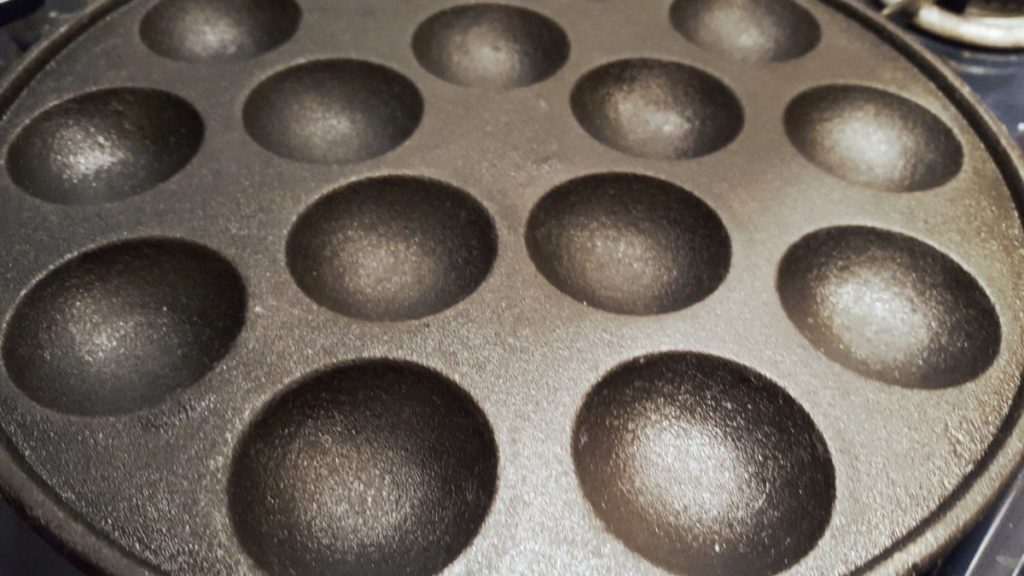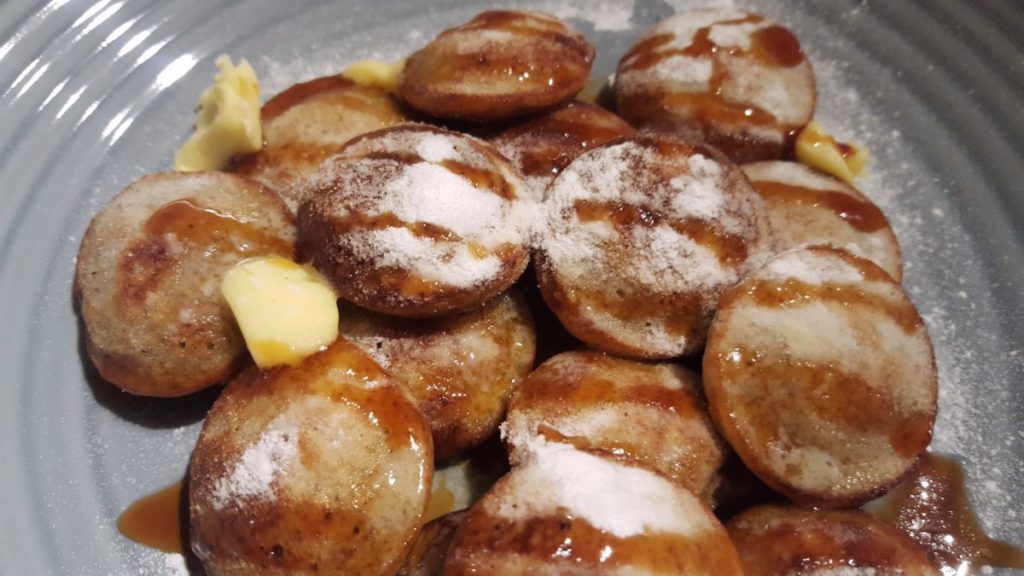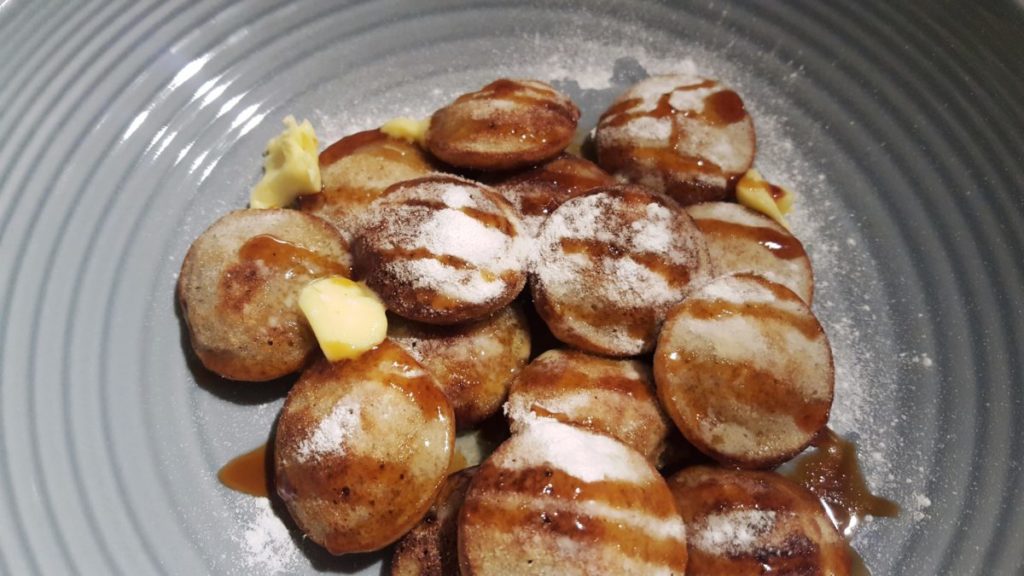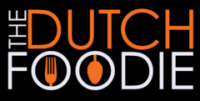It doesn’t need to be Pancake Day for the Dutch to eat pancakes. We eat them any time of the year, for breakfast, brunch, lunch, as a dessert, tea time treat or even dinner.
We simply love pancakes. Sweet ones with jam or fruit or chocolate or apple spread or “pouring syrup” or ice cream. Savoury ones with bacon or vegetables or cheese and ham. Or ones that combine both sweet and savoury, my favourite apple and bacon with tart Dutch apple spread (“appel stroop”).
The large ones give pizza a good run for their money and you’d need at least a pizza plate to serve them. But there’s puffy little dainty ones like these “poffertjes” as well.
Their name is derived from the Dutch word “pof”, which means “puff”, referring both to the way they puff up while they cook, and the slight “pfff” sound they make as they do so.
Contrary to their larger cousins, these little pancakes are yeasted and baked in a special “poffertjes pan”, preferably cast iron for even heat distribution. These pans have 12-15 indentations for the batter.
They are not dissimilar to the pans the Danish use for their traditional aebleskiver (pancake puffs), or the Japanese for their octopus Takoyaki. The indentations in the poffertjes pan are shallower though, so they don’t come out as spherical as the Danish or Japanese versions.
 My family hails from the Southern province of Brabant, where these little treasures are not served as often as they are in other parts of the Netherlands (and never at my childhood home, as we opted for the larger variety, thickly spread with jam and then rolled up).
My family hails from the Southern province of Brabant, where these little treasures are not served as often as they are in other parts of the Netherlands (and never at my childhood home, as we opted for the larger variety, thickly spread with jam and then rolled up).
Poffertjes are a staple at Dutch markets and fairs though. It’s quite a theatre seeing them made by the professionals on huge poffertjes plates, filling them very quickly with their batter dispensers, turning them with the flick of the wrist before you’ve said the word “poffertje”.
They are traditionally served liberally sprinkled with icing sugar and a good dollop of melting butter. Usually unsalted butter, but I quite like slightly salted to counterbalance all that sugar.
I admit this is the first time I’ve made poffertjes. I have no idea what possesses me, but lately I feel strangely compelled to express my ultimate Dutch-ness. I even invested in a special poffertjes pan as a token of my commitment. And one of the traditional long stemmed wooden forks for turning them (even though I know any fork or skewer would do). I also dug out my squeezy bottle from the back of the cupboard, as it’s so much easier to dispense the batter into the pan that way, rather than messing about with spoons.
Don’t panic if you don’t have a poffertjes pan. These tiny treats can be made in a good non-stick pan or on a sturdy griddle as well.
I kept the recipe traditional this time to test the water. But my mind is already whizzing around like crazy with ideas to experiment and inventing savoury versions as well. I think the pan will be useful for making cocktail blinis too, so winner winner chicken dinner. O. No. Sorry , that’s tomorrow. Chicken dinner that is.
THE RECIPE
Traditional Poffertjes – Dutch Mini Pancakes (serves 4 )

You can make these gluten free by using gluten free flour and gluten free yeast.
Like with most baking, make sure all the ingredients are at room temperature.
Ingredients
400 ml milk, hand-warm
7 gr dry yeast (I used Allinson easy bake yeast)
125 gr buckwheat flour
125 plain flour (or use more buckwheat flour or a GF baking flour. I used unrefined brown flour)
1/2 tsp (GF) baking powder (optional as the yeast should give the rise)
a pinch of salt
50 gr melted butter
1 scant tbsp Dutch “Schenkstroop” (pouring syrup), maple syrup, runny honey or unrefined caster sugar
1 egg
Butter or oil for frying (I used a coconut oil spray)
Icing sugar and butter for serving. I went greedy and had Schenkstroop as well, but that’s not traditional on poffertjes. Very nice though. You could indulge with maple syrup or runny honey.
Method
Mix the yeast with the milk and set aside for 10 mins or so until bubbles start to form.
Sift both flours into a large mixing bowl and combine with the baking powder (if using) and a pinch of salt. Add the yeasted milk and mix with a whisk or electric mixer.
Add the melted butter and syrup or sugar. Mix again. Beat the egg in a separate bowl and add to the batter. Mix to combine until you have a smooth yet reasonably thick batter (not as thin as crepes or normal pancakes).
Cover and set aside for minimum 1 hour in a warm place to let the yeast do its thing.
 Heat the pan over medium-high heat. Wait until the pan or griddle are hot before doing anything else. Then grease the pan or griddle liberally with butter or oil. Use a pastry brush or piece of kitchen paper to ensure all the holes are well-covered.
Heat the pan over medium-high heat. Wait until the pan or griddle are hot before doing anything else. Then grease the pan or griddle liberally with butter or oil. Use a pastry brush or piece of kitchen paper to ensure all the holes are well-covered.
Spoon or pipe batter into each hole (or on the griddle if you’re not using a poffertjes pan. Be sure to space them out in that case, as they may spread a little). Don’t overfill the holes, 3/4 full is plenty to allow for a little rise.
Wait until holes are starting to appear in the top and the top is as nearly dry. Then flip each one by one using a fork or skewer. I find a coffee spoon quite handy too, but that’s probably because I am a poffertjes beginner.
 Cook until golden on the other side as well.
Cook until golden on the other side as well.
Keep them warm in a low oven while you continue with the next batch until all the batter is used up.
Serve dusted with clouds of icing sugar and dotted with butter. Syrup, maple syrup, agave or runny honey optional.
Leftovers freeze well, but I doubt leftovers will be your problem. More likely you’ll have to stir up more batter, because everyone will want seconds.







